Pavement Management Program
2025 Pavement Management Program
Welcome to the City’s roadwork page where you can find out if your street is on this year’s list for an upgrade and learn all about the City’s Pavement Management Program. Almost 1.8 million square feet of streets will be treated this year.
View a map of current road work in the area here. For Slurry Seal Project Schedule click here.
City of Pleasanton – Summer 2025 Street Resurfacing Program
The City of Pleasanton’s 2025 Street Resurfacing Program includes two major projects: the Annual Street Resurfacing Project (CIP No. 25503) and the Annual Slurry Seal Project (CIP No. 25504). These efforts are part of our ongoing commitment to maintaining and improving the quality and safety of our roadways.
- Annual Street Resurfacing – CIP No. 25503
- Scope of Work:
Repaving and rehabilitating approximately 1.03 million square feet of roadway across 21 street segments. This project also includes preparatory pavement repair and crack sealing work for approximately 0.75 million square feet of roadway scheduled for slurry seal treatment under CIP No. 25504. - What to Expect:
Work will include various construction activities such as:- Pavement repair and recycling
- Asphalt grinding
- Installation of traffic detector loops
- Placement of new asphalt concrete
- Utility box adjustments
- Striping and pavement markings
Each operation typically lasts 1 to 3 days per street. Streets will be limited to vehicle access during active construction and will be closed to vehicular traffic during paving operation (placement of hot mix asphalt concrete) . No driveway access will be permitted while work is occurring in front of your property. Emergency vehicle access will be maintained at all times.
Parking restrictions will be posted with A-frame barricades at least 48 hours in advance. Construction work hours are typically from 8:00 AM to 5:00 PM or as posted on A-frame barricades.
- Contractor: O’Grady Paving
- Start of Construction: August 11, 2025 (Preparatory work begins)
- Expected Completion: December 1, 2025
- Construction Cost: $4,038,462
- Funding Sources: Gas Tax, SB-1, Measure BB, and Measure F
- CIP 25503-Anticipated 3-Week Rolling Schedule Map
Annual Slurry Seal – CIP No. 25504
- Scope of Work:
Slurry seal application on approximately 0.75 million square feet of pavement across 33 street segments, designated for preventative maintenance.
This project will occur in two phases:
- Phase 1: Pavement repairs and crack sealing performed under the Annual Street Resurfacing Project (CIP No. 25503), beginning August 11, 2025. (completed)
- Phase 2: Application of a slurry mixture (a thin layer of asphalt and aggregate) to seal the road surface. (completed)
- Sweeping and touch up.
- What to Expect:
Phase 2 activities will include slurry seal application, pavement striping, and marker installation.
Streets will be closed to vehicular traffic during work. No driveway access will be allowed during active slurry sealing. Emergency access will always be provided.
Parking restrictions will be posted with A-frame barricades at least 48 hours in advance. Work hours are typically from 8:00 AM to 5:00 PM. - Contractor: Sierra Nevada Construction, Inc.
- Start of Construction: September 15, 2025 with four (4) days of slurry September 19-23
- Expected Completion: October 30, 2025 with placement of striping
- Construction Cost: $293,007
- Funding Source: Gas Tax
Contact Information
For questions or more information, please contact:
Huy Ho
Email: [email protected]
Phone: (925) 931-5663
Ever wonder how the city prioritizes street work, click here.
Did you know that there are 518 lane miles of paved roads in Pleasanton? The goal of the Pavement Management Program is to maintain City streets and keep them in good driving condition, which requires a considerable amount of thought and effort.
Slurry Seal Overview and FAQs
Slurry seal is a petroleum-based emulsion product, mixed with sand and fine black aggregate rock. It is blended on-site in a large truck and then applied evenly across the entire roadway surface of an asphalt street. The slurry seal is typically 1/4 to 3/8 of an inch thick.
What does slurry seal do?
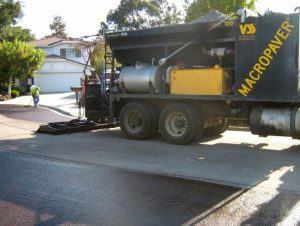
Streets deteriorate over time and exposure to weather and the more extreme the weather, the more quickly streets degrade.
Slurry seal, because of its composition and strengthening additives, works to counter the effects of weather and extend the life of the road.
In addition to providing a new wearing surface, slurry seal will also correct minor roadway defects that have appeared over time.
What happens before the streets are slurry sealed?
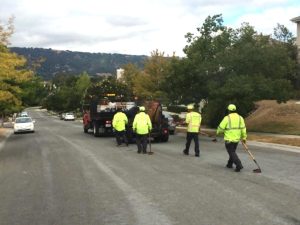
Before streets can be slurry sealed, concrete improvements, base repairs and crack sealing all need to occur by crews with specific expertise in that area.
Concrete improvements: Severely damaged and poorly draining curbs are replaced. Severely damaged sidewalk and curb ramps will also be replaced. This work typically begins in the winter and is completed in the spring, prior to roadway work.
Base repairs: Failing areas under the pavement will be dug up and replaced. Base repairs are typically small (around 4 feet or so). The daylong process involves sawing, cutting and removing old pavement, then paving over the repaired area. Temporary “potholes” result during this process, so be sure to watch for the cones and avoid the area. You can usually have access to your driveway unless repairs are in front of it. “No parking” signs will be posted 48 hours in advance so crews can work and prevent damage to cars. Base repairs are done by a separate contractor and typically start within a month or two of the slurry seal work.
Crack sealing: Cracks in the roadway will be covered with an asphalt material to help seal the road surface. Cracks need to be wider than 3/8 of an inch. Cracks will be cleaned out with compressed air and the hot material will be poured into the cracks. The process only takes a few minutes per crack and will not impact access to your home. The process is relatively quick and the newly sealed crack can be crossed in a matter of minutes; however, the recommended waiting period is one hour before crossing to ensure sufficient cooling and curing has taken place. And hot days require longer waiting periods as the material remains soft for a longer time and can stick to shoes and create tire tracks.
If at all possible, we ask you to avoid the areas to ensure the optimal outcome for street repairs. Crack sealing takes place a few weeks after the base repairs, but within a month of the slurry seal work.
What can I expect prior to and during the slurry seal process?
Public outreach from the City through press releases, as well as social media, will occur a week or two prior to the start.
48-hour notices will be sent prior to start of work and no parking signs will be installed on barricades on the street. The 48-hour notice will have the contact name and number for the City inspector if special arrangements for access need to made.
All vehicles and other objects must be removed from the street. This includes trailers, garbage cans, basketball hoops, etc.
The morning of the slurry seal, the street is swept with a mechanical street sweeper and any weeds are removed.
The slurry paver will place a liquid mixture of asphalt on the section of pavement; sand and strengthening additives are poured on to the road surface, which typically affects only one half of the street at any given time.
While motorists can drive on the slurry seal application a few hours after it has been applied, it takes a couple of weeks to fully cure. During the first few hours while the slurry cures, motorists, pedestrians and pets must stay out of the slurry seal so as not to ruin the application and to avoid getting the seal on vehicles, shoes and paws.
During the day of placement and while the curing process is taking place, the areas will be gone over with a roller and swept to remove loose material. Debris on sidewalks and driveways will be blown into the street to be picked up by the street sweepers.
Once the slurry has cured enough for traffic, it will be reopened to traffic. At this time, the slurry is very tender. Any sharp turns and turning of vehicle wheels while not moving will tear the surface. Please be sure to avoid making sharp turns or turning your wheels while not moving to keep the street looking its best. It will take several days before sharp turns won’t cause tears in the surface of the slurry seal.
Within 48 hours, an additional street sweeping will take place. Please be sure to remove objects from the street so the sweepers can pick up the loose slurry materials. If it has been 72 hours and the street has not been swept, please contact the City Inspector.
Within a few weeks after the slurry has been placed and has cured enough, traffic striping will be installed.
As the slurry seal cures it will turn from brown to black and the street typically has a sandy or gravel-like coating. This sand is picked up by street sweepers once the curing process is complete. Please check the City’s sweeping schedule the first month after slurry seal placement and be sure to clear the street so the sweepers can pick up these loose materials.

How will the slurry seal application affect me?
Your street will be closed for one day, from 8 a.m. to approximately 5 p.m. You will not have vehicle access to your driveway during that time, though pedestrian access will be maintained. When the slurry seal is applied, it looks liquid like chocolate syrup but it is much stickier and messier. Slurry seal takes several hours to dry. During that time, motorists, pedestrians and pets must stay out of the slurry seal so as not to ruin the application and to avoid getting slurry seal on vehicles, shoes and paws. It will take longer to cure in shaded areas.
You must avoid outdoor water use if it causes water to flow onto the street. Water will hinder the slurry seal curing process. If you water your lawn or wash your car on slurry seal day, please make sure the water does not flow onto the street.
What if I need to drive somewhere?
What if there is an emergency?
What about garbage pickup, mail delivery, or other expected deliveries from service providers?
What if it rains?
Light rain or passing showers may not delay the slurry seal application, however, slurry seal cannot be applied in heavy or steady rain. If we have or anticipate significant rainfall, the slurry seal application may be postponed to another day.
What can I do to make the work go smoothly?
- Plan ahead and anticipate parking issues and how you will get in and out. Park on nearby, unaffected streets if necessary. Try to reschedule any visitors or deliveries.
- Keep children and pets away from the street while treatment is being performed. Several large pieces of contractor equipment are involved.
- Whenever possible, avoid construction areas and use alternate access routes.
- Check your shoes before walking into your house. The loose rocks can be picked up and tracked onto carpets or scratch wood floors.
- Respect construction signs, cones and barricades. Do not drive around.
- Drive slowly; the pavement can be slippery because of the loose rock. Do not drive on the treated streets until the lanes have been reopened to traffic.
- Warn your children to be careful while riding their bicycles. It would be preferable if they refrained from riding altogether until the loose rock is swept up.
- Continue to park your car off your street or cover it until the initial sweeping is completed. Loose rock thrown up by speeding vehicles could damage your car’s paint.
We realize this surface treatment is an inconvenience to residents, but the alternative of doing nothing will result in accelerated pavement deterioration that may lead to costly and less effective methods of repair. We appreciate your cooperation and patience as we make these important improvements in your neighborhood.
Street Resurfacing Overview & FAQs
Streets tend to deteriorate due to weathering which gradually wears down the pavement’s asphalt binder – the sticky stuff that holds the pavement together. On newer street surfaces, a slurry seal application can be applied to seal the surface in good condition as part of ongoing preventative maintenance. After the pavement surface is no longer suitable for slurry coating (typically after one or two slurry seal applications) pavement rehabilitation is necessary. Pavement rehabilitation replaces or overlays the streets with a new layer of asphalt. The process is targeted for streets that are in fair condition.
It takes many different operations to complete all of the work and there can be a delay of several weeks between the operations.
What happens before the streets are overlaid?
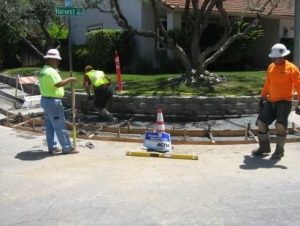
Concrete Improvements: The City starts the process by replacing damaged and poorly draining curb and gutters. Under the Americans with Disabilities Act (ADA) and City’s ADA transition plan, curb ramps that are missing or outdated will be replaced. While the concrete contractor is in the area, severely damaged sidewalks will also be removed and replaced. The concrete work will be done by a separate contractor and is typically done a few months prior to the resurfacing taking place.
Base Repair Mark Outs: During the design phase, the Engineering Department will begin marking out the areas where the pavement has failed as part of pavement assessment and evaluation process. This process typically takes place a few months before resurfacing. These marked out areas will be revisited and updated for necessary base repair areas.
What is the overlay process and what should you expect?
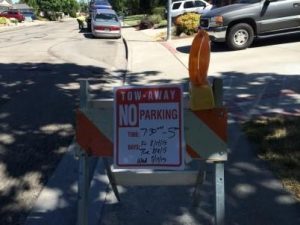
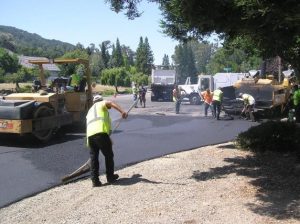
- 48-hour notices will be hand delivered and “no parking” signs will be installed on barricades on the street for each operation that impacts the street. The 48-hour notices will be delivered ONLY ONCE before the first phase of the entire process and both the contractor’s and the City inspector’s name and phone numbers will be included if special arrangements for access need to be made.
- Please remove all vehicles and other objects from the street; this includes trailers, garbage cans, basketball hoops, etc. The no parking dates are typically set up for three days to allow for variability in the contractor’s schedule. The process has many variables outside of the control of the contractor that can impact production, so a flexible three-day window is required. If the contractor misses the window, the area will be re-noticed with a full 48-hours advance notice.
- Please be sure to read the signs as they are changed regularly.
- Vehicles left on the street during the no parking period could be towed, with the cost of towing being borne by the vehicle owner.
As you can see, the process has many phases to it, as follows:
Base Repairs: Areas of the roadway where the supporting dirt and stone under the pavement has failed will be dug up and replaced. The process takes a single day, during which the crews come out and saw cut and remove the old pavement for several streets and then pave back the repair area by the end of the day. There will be temporary potholes during the day when the pavement is removed and prior to being paved back, so be sure to watch for the cones. Unless the repair is in front of your driveway, you will typically have access to your driveway throughout the day. If you see paint marks right at your driveway please make arrangements to move your car if you will need access during the day. The street will be posted for no parking 48 hours in advance to provide room for the crews to work and prevent damage to any cars. This work typically takes place several weeks before the street will be resurfaced.
Milling: Milling is a process that grinds away a portion of the existing asphalt to make smooth transitions between the new and old surfaces. The 48-hour no parking signs will be placed back on the street prior to the work, however, access in and out of driveways will be maintained. The contractor will periodically sweep the area to pick up loose stone until the surface is paved (paving typically occurs within ten days after the surface has been milled).
Crack Sealing: Some streets will receive a crack seal treatment. Cracks in the roadway will be covered with an asphalt material to help seal the road surface. The process only takes a few minutes per crack and will not impact your access to your home. Once the crack filling material goes down it takes just minutes for it to cool and dry enough to cross, however, we recommend waiting an hour before crossing for it to cool down and avoid it sticking to vehicle tires. On very warm or hot days, the material can be soft and sticky longer, so please try to avoid walking on it or driving on it if possible.
Paving: The day of paving will be a very busy day in the area with major truck traffic. 48-hour no parking signs will be posted, including areas outside of the streets being paved, to provide an area for the contractor trucks to stage. It takes only a couple of hours to pave a typical residential street and several streets will be completed in a day. The day of paving, you will not have access to your driveway until the roadway is opened back up.
Paving is done in the following steps:
- Streets will be swept with a street sweeper and the temporary asphalt at curb ramps and conforms will be removed.
- An application of a sticky layer called “tack coat” will be placed, which helps the asphalt adhere to the roadway. Avoid driving or walking on the tack coat as it will stick to your tires and shoes.
- Some streets will have a pavement fabric installed. The fabric uses to bridge imperfections and avoid having them reflect up through the new pavement material. Please be sure not to drive on the fabric.
- A new layer of asphalt will be placed onto the existing pavement with paving machines.
- Rollers will follow the paving equipment for compaction.
- Sidewalks, driveways and streets will be cleaned of loose stone.
- Temporary striping or “floppies” will be installed.
- Resurfaced streets can be driven on as soon as construction crews reopen the lane or street. Streets will be reopened typically within two-to-three hours after the pavement has been placed and rolled.
- The next day, street sweepers will return to clean the streets as necessary to pick up any remaining loose stones.
- Raising Iron: The manhole covers, water valve covers, etc., will be raised to the new grade following the paving. This process typically takes one to two days per street. Only the locations where the iron needs to be raised will be noticed with no parking signs. During the raising process, cones and barricades will be placed over the irons and there will be potholes. Please go around these cones or barricades until the area is paved back. After the concrete has had a chance to cure, the top surface will be paved back, typically within 48 hours.
- If the cones or barricades are removed after the concrete curing process, you may drive over these irons but expect a bump.
- Striping: Pavement markings will typically be reinstalled within two to three weeks after paving. Most residential streets will not be impacted by the placement of pavement markings. The process takes less than an hour for most locations and typically occurs at the intersections.
When can I drive on the street after it’s paved? Can I walk or ride my bike on the fresh asphalt?
When it is safe to use the street again, the street closure barriers will be removed. Once the paving equipment has moved down the street, several processes need to take place to cure the new surface, including cooling the hot asphalt which normally takes two to three hours. Please do not drive, walk, bike or otherwise travel on the newly resurfaced streets until the barriers are removed; the extremely hot and sticky pavement may be damaged—and so might your vehicle. Driving on the surface too soon will also track black material all over your neighborhood and your driveway.
How will the overlay affect me?
Street parking will be affected several times as prep work is completed prior to paving. The day of paving, the affected street(s) will be closed from 8 a.m. to approximately 5 p.m. You will not have vehicle access to your driveway during that time, however, pedestrian access will be maintained.
Please do not water on the day crews are scheduled to work on your street. Automatic sprinklers should be turned off to avoid accidental watering during construction. Streets that are wet prior to paving cause problems during construction and additional work or rescheduling may be necessary.
What about garbage pickup, mail delivery, or other expected deliveries from service providers?
Street resurfacing is coordinated with the postal service, garbage haulers and other service providers. In most cases, you will not experience any service interruptions. Put garbage cans out early on your regular collection day, preferably at the edge of your driveway rather than in the street. Garbage haulers and mail carriers will work around the paving operation to provide service, however, it may not be at the usual time of day.
What if there is an emergency?
What if I have a special event on the day(s) noticed for no parking or I have an appointment and have difficulty walking?
Please contact the construction inspector and contractor on the 48-hour notice to make special arrangements. If you have concerns please feel free to contact the City Engineering Department at (925) 931-5650.
I forgot the paving will take place today and I need to get out, but barricades are up and closing the street. What should I do?
Please contact the construction inspector or contractor on the 48-hour notice or flag down construction personnel in the area. The staff can provide direction on how to proceed, but please understand that there may be a wait. Please do not drive across the pavement if the new surface is already down, as that may damage the street and your vehicle. Unless the paving process is working on the street, you can typically be escorted out of the work zone.
What if it rains?
If significant rains are in the forecast, the work may need to be rescheduled. If only light rains are forecast, then some work may continue, however, paving cannot be done during rain. Streets will be reposted with new dates if the work is rescheduled. You will be notified of the new application date via a door hanger notice and signs along your street.
What if I need to drive somewhere?
Park your vehicle on a nearby street that is not being worked on. Check the area signage to plan your route and where to park. The streets are phased to provide room for parking on adjacent streets.
What if my car was parked in the street and is now missing?
Please contact the police department at (925) 931-5100. Cars that remain parked on the affected street after the street has been notified 48 hours in advance of the temporary no parking zones can be towed under the City’s Municipal Code. The City makes every attempt to contact the owner prior to towing the vehicle, however, the vehicles will be towed if necessary to complete the street work.
The contractor has worked on my street for a few hours then there is no construction activity in the last 10 days. When are they returning to my street?
There are multiple phases to complete the overlay process as mentioned above. Sometimes, there is a long period between each operation as the contractor is busy working on other streets. There are typically 40 or more streets scheduled for overlay yearly.
What can I do to make the work go smoothly?
- Plan ahead and anticipate parking issues and how you will get in and out. Park on nearby, unaffected streets if necessary. Try to reschedule any visitors or deliveries.
- Keep children and pets away from the street while treatment is being performed. Several large pieces of contractor equipment are involved.
- Whenever possible, avoid construction areas and use alternate access routes.
- Check your shoes before walking into your house. The loose rocks can be picked up and tracked onto carpets or scratch wood floors.
- Respect construction signs, cones and barricades. Do not drive around.
- Drive slowly; the pavement can be slippery because of the loose rock. Do not drive on the treated streets until the lanes have been reopened to traffic.
- Ask your children to be careful while riding their bicycles. It would be preferable if they refrained from riding altogether until the loose rock is swept up.
- Continue to park your car off your street or cover it until the initial sweeping is completed. Loose rock thrown up by speeding vehicles could damage your car’s paint.
If you have any questions or comments on the project, you can contact us by:
- Calling the City’s Engineering Department at (925) 931-5650.
- Filling out our Contact form.
- Posting a comment on the Citizen Request portal.
